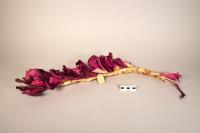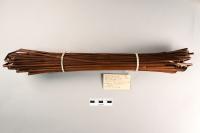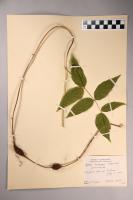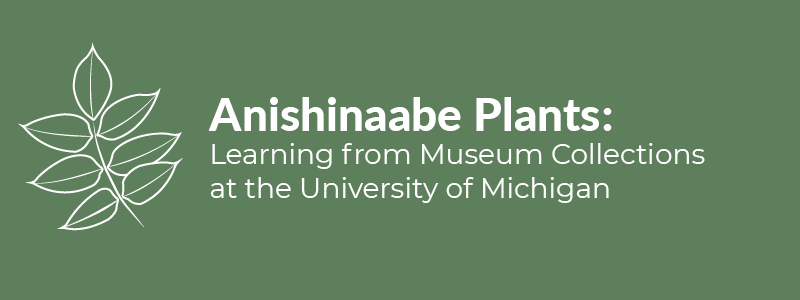-
 Corn Husk Mat
Corn Husk Mat Corn husk mat made of husks dyed with Turkish dyes. This mat won first prize when exhibited at the Walpole Fair in August 1932 (from Volney Jones' 1933 field notes).
-
 Braided Corn Husks
Braided Corn Husks Corn husks woven into strips which is to be sewed into mat (from Volney Jones' 1933 field notes).
-
 Dyed Corn Husks
Dyed Corn Husks Corn husks dyed with Turkish dyes, to be used in making mat (from Volney Jones' 1933 field notes).
-
 Oak Bark
Oak Bark Bark of oak used to make dye by Mrs. Smith. Collected across the road from her house (from Volney Jones' 1933 field notes).
-
 Oak
Oak Pressed specimen of oak collected by Mrs. Smith across from her house. Bark of this oak used in making dye (from Volney Jones' 1933 field notes, Field no. 11).
-
 Maple Bark
Maple Bark Bark of maple tree used by Mrs. Smith in making the walnut dye (from Volney Jones' 1933 field notes).
-
 Silver Maple
Silver Maple Pressed specimen of maple collected by Mrs. Hyman Smith in woods across road from her house. Bark under same number used in making dye (from Volney Jones' 1933 field notes, Field no. 10).
-
 Comb Basket
Comb Basket Open weave. Loose weave three-directional basket technique. This type of weave is said by Mrs. Smith to have been learned by her mother from the Ottawa. Mrs. Greenbird seems to be the only person on the island doing it at present. The carrying basket in Eddie Pinnance's barn is of this weave (from Volney Jones' 1933 field notes).
-
 Open Weave Basket
Open Weave Basket Basket made by Mrs. Smith's daughter (Myra Greenbird). Purple. Hexagonal bottom with circular top rim (from Volney Jones' 1933 field notes).
-
 Dyed Rush Reeds
Dyed Rush Reeds Bundle of rushes dyed with walnut bark (from Volney Jones' 1933 field notes).
-
 Black Walnut Bark
Black Walnut Bark Pressed specimen of black walnut collected with Mrs. Hyman Smith behind the house of Charley Sword. Black walnut is rather scarce on the island. It is a strip of inner bark, ready to use as dye (from Volney Jones' 1933 field notes, Field no. 9).
-
 Black Walnut Log
Black Walnut Log Log of black walnut, bark for dye partly removed (from Volney Jones' 1933 field notes). Prepared by Mrs. Hyman Smith (from UMMAA catalog book).
-
 Rush Mat, partially finished
Rush Mat, partially finished Partly finished. Series of long fibers (rush) braided together along one end with three strands of plant fiber woven into same edge to hold all together. Remainder is loose, unwoven rush fibers. Fiber cordage is attached to edges and ties mat in rolled bundle (from Volney Jones' 1933 field notes).
-
 Rush Reed, prepared
Rush Reed, prepared 10 long, thin pieces of rush (shafts). Thicker at one end than the other. Rushes bundled, cleaned, dried, cut. Ready to weave into mat (from Volney Jones' 1933 field notes).
-
 Wood Game Piece
Wood Game Piece Object made by Hyman Smith's son. Used in throwing game. Made of hickory (from Volney Jones' 1933 field notes, Field no. 122).
-
 Softstem Bulrush
Softstem Bulrush Includes complete dried plants (flowers, stems, and roots). Bulrush reed used for mat by Smith (from Volney Jones' 1933 field notes, Field no. 4).
-
 Softstem Bulrush
Softstem Bulrush Pressed specimen of bulrushes as used for mat made by Mrs. Hyman Smith (UMMAA 13974) (from Volney Jones' 1933 field notes, Field no. 4).
-
 Red Maple
Red Maple Pressed specimen of maple, collected in same place as no. 6 and 7, called "soft maple" by Sturgeon. It is the type used by Dave Osahgee and other workers in soft wood for the making of novelties (from Volney Jones' 1933 field notes, Field no. 8).
-
 Potato Bean
Potato Bean Pressed specimen of Potato Bean (Apios tuberosa) collected along fences on east side of Sturgeon's house. There were several vines, some with five leaflets and some with seven. None were in flower. Collected 7/12/33. Sturgeon knew that they were formerly used for food, but knew nothing of the preparation (from Volney Jones' 1933 field notes, Field no. 5).
-
 Potato Bean
Potato Bean Pressed specimen of Potato Bean (Apios tuberosa) collected along fences on east side of Sturgeon's house. There were several vines, some with five leaflets and some with seven. None were in flower. Collected 7/12/33. Sturgeon knew that they were formerly used for food, but knew nothing of the preparation (from Volney Jones' 1933 field notes, Field no. 5).
-
 Potato Bean
Potato Bean Pressed specimen of Potato Bean (Apios tuberosa) collected along fences on east side of Sturgeon's house. There were several vines, some with five leaflets and some with seven. None were in flower. Collected 7/12/33. Sturgeon knew that they were formerly used for food, but knew nothing of the preparation (from Volney Jones' 1933 field notes, Field no. 5).
-
 Sweetgrass
Sweetgrass Pressed specimen of sweet grass, obtained from Levi Sturgeon. From field beside Dave Osahgee's house. Said by Sturgeon to have been planted there by his father. He says that sweet grass can easily be transplanted from roots. He recognized sweet grass by the glossy upper surface of the leaf, its low branching characteristics, and lack of joints in nodes. The sweet grass was growing among other plants. He says it does better with competition. Collected 7/7/33 (from Volney Jones' 1933 field notes, Field no. 1).
-
 Black Ash
Black Ash Leaves of black ash from tree about 30 feet tall, cut on farm of William George, an old Pottawatomie farmer living on the back part of the island. The tree was bought through Levi Sturgeon for 75 cents (from Volney Jones' 1933 field notes, Field no. 2).
-
 Black Ash
Black Ash Leaves and twigs of black ash from tree about 30 feet tall, cut on farm of William George, an old Pottawatomie farmer living on the back part of the island. The tree was bought through Levi Sturgeon for 75 cents (from Volney Jones' 1933 field notes, Field no. 2).
-
 Swamp Milkweed
Swamp Milkweed Pressed specimen of Swamp Milkweed (Asclepias Incarnata) from plant about three feet tall with pale rose-colored flowers. Collected on the farm of William George and said by him to have formerly been used as a source of fibers for cordage (from Volney Jones' 1933 field notes, Field no. 3).
 Corn Husk Mat Corn husk mat made of husks dyed with Turkish dyes. This mat won first prize when exhibited at the Walpole Fair in August 1932 (from Volney Jones' 1933 field notes).
Corn Husk Mat Corn husk mat made of husks dyed with Turkish dyes. This mat won first prize when exhibited at the Walpole Fair in August 1932 (from Volney Jones' 1933 field notes). Braided Corn Husks Corn husks woven into strips which is to be sewed into mat (from Volney Jones' 1933 field notes).
Braided Corn Husks Corn husks woven into strips which is to be sewed into mat (from Volney Jones' 1933 field notes). Dyed Corn Husks Corn husks dyed with Turkish dyes, to be used in making mat (from Volney Jones' 1933 field notes).
Dyed Corn Husks Corn husks dyed with Turkish dyes, to be used in making mat (from Volney Jones' 1933 field notes). Oak Bark Bark of oak used to make dye by Mrs. Smith. Collected across the road from her house (from Volney Jones' 1933 field notes).
Oak Bark Bark of oak used to make dye by Mrs. Smith. Collected across the road from her house (from Volney Jones' 1933 field notes). Oak Pressed specimen of oak collected by Mrs. Smith across from her house. Bark of this oak used in making dye (from Volney Jones' 1933 field notes, Field no. 11).
Oak Pressed specimen of oak collected by Mrs. Smith across from her house. Bark of this oak used in making dye (from Volney Jones' 1933 field notes, Field no. 11). Maple Bark Bark of maple tree used by Mrs. Smith in making the walnut dye (from Volney Jones' 1933 field notes).
Maple Bark Bark of maple tree used by Mrs. Smith in making the walnut dye (from Volney Jones' 1933 field notes). Silver Maple Pressed specimen of maple collected by Mrs. Hyman Smith in woods across road from her house. Bark under same number used in making dye (from Volney Jones' 1933 field notes, Field no. 10).
Silver Maple Pressed specimen of maple collected by Mrs. Hyman Smith in woods across road from her house. Bark under same number used in making dye (from Volney Jones' 1933 field notes, Field no. 10). Comb Basket Open weave. Loose weave three-directional basket technique. This type of weave is said by Mrs. Smith to have been learned by her mother from the Ottawa. Mrs. Greenbird seems to be the only person on the island doing it at present. The carrying basket in Eddie Pinnance's barn is of this weave (from Volney Jones' 1933 field notes).
Comb Basket Open weave. Loose weave three-directional basket technique. This type of weave is said by Mrs. Smith to have been learned by her mother from the Ottawa. Mrs. Greenbird seems to be the only person on the island doing it at present. The carrying basket in Eddie Pinnance's barn is of this weave (from Volney Jones' 1933 field notes). Open Weave Basket Basket made by Mrs. Smith's daughter (Myra Greenbird). Purple. Hexagonal bottom with circular top rim (from Volney Jones' 1933 field notes).
Open Weave Basket Basket made by Mrs. Smith's daughter (Myra Greenbird). Purple. Hexagonal bottom with circular top rim (from Volney Jones' 1933 field notes). Dyed Rush Reeds Bundle of rushes dyed with walnut bark (from Volney Jones' 1933 field notes).
Dyed Rush Reeds Bundle of rushes dyed with walnut bark (from Volney Jones' 1933 field notes). Black Walnut Bark Pressed specimen of black walnut collected with Mrs. Hyman Smith behind the house of Charley Sword. Black walnut is rather scarce on the island. It is a strip of inner bark, ready to use as dye (from Volney Jones' 1933 field notes, Field no. 9).
Black Walnut Bark Pressed specimen of black walnut collected with Mrs. Hyman Smith behind the house of Charley Sword. Black walnut is rather scarce on the island. It is a strip of inner bark, ready to use as dye (from Volney Jones' 1933 field notes, Field no. 9). Black Walnut Log Log of black walnut, bark for dye partly removed (from Volney Jones' 1933 field notes). Prepared by Mrs. Hyman Smith (from UMMAA catalog book).
Black Walnut Log Log of black walnut, bark for dye partly removed (from Volney Jones' 1933 field notes). Prepared by Mrs. Hyman Smith (from UMMAA catalog book). Rush Mat, partially finished Partly finished. Series of long fibers (rush) braided together along one end with three strands of plant fiber woven into same edge to hold all together. Remainder is loose, unwoven rush fibers. Fiber cordage is attached to edges and ties mat in rolled bundle (from Volney Jones' 1933 field notes).
Rush Mat, partially finished Partly finished. Series of long fibers (rush) braided together along one end with three strands of plant fiber woven into same edge to hold all together. Remainder is loose, unwoven rush fibers. Fiber cordage is attached to edges and ties mat in rolled bundle (from Volney Jones' 1933 field notes). Rush Reed, prepared 10 long, thin pieces of rush (shafts). Thicker at one end than the other. Rushes bundled, cleaned, dried, cut. Ready to weave into mat (from Volney Jones' 1933 field notes).
Rush Reed, prepared 10 long, thin pieces of rush (shafts). Thicker at one end than the other. Rushes bundled, cleaned, dried, cut. Ready to weave into mat (from Volney Jones' 1933 field notes). Wood Game Piece Object made by Hyman Smith's son. Used in throwing game. Made of hickory (from Volney Jones' 1933 field notes, Field no. 122).
Wood Game Piece Object made by Hyman Smith's son. Used in throwing game. Made of hickory (from Volney Jones' 1933 field notes, Field no. 122). Softstem Bulrush Includes complete dried plants (flowers, stems, and roots). Bulrush reed used for mat by Smith (from Volney Jones' 1933 field notes, Field no. 4).
Softstem Bulrush Includes complete dried plants (flowers, stems, and roots). Bulrush reed used for mat by Smith (from Volney Jones' 1933 field notes, Field no. 4). Softstem Bulrush Pressed specimen of bulrushes as used for mat made by Mrs. Hyman Smith (UMMAA 13974) (from Volney Jones' 1933 field notes, Field no. 4).
Softstem Bulrush Pressed specimen of bulrushes as used for mat made by Mrs. Hyman Smith (UMMAA 13974) (from Volney Jones' 1933 field notes, Field no. 4). Red Maple Pressed specimen of maple, collected in same place as no. 6 and 7, called "soft maple" by Sturgeon. It is the type used by Dave Osahgee and other workers in soft wood for the making of novelties (from Volney Jones' 1933 field notes, Field no. 8).
Red Maple Pressed specimen of maple, collected in same place as no. 6 and 7, called "soft maple" by Sturgeon. It is the type used by Dave Osahgee and other workers in soft wood for the making of novelties (from Volney Jones' 1933 field notes, Field no. 8). Potato Bean Pressed specimen of Potato Bean (Apios tuberosa) collected along fences on east side of Sturgeon's house. There were several vines, some with five leaflets and some with seven. None were in flower. Collected 7/12/33. Sturgeon knew that they were formerly used for food, but knew nothing of the preparation (from Volney Jones' 1933 field notes, Field no. 5).
Potato Bean Pressed specimen of Potato Bean (Apios tuberosa) collected along fences on east side of Sturgeon's house. There were several vines, some with five leaflets and some with seven. None were in flower. Collected 7/12/33. Sturgeon knew that they were formerly used for food, but knew nothing of the preparation (from Volney Jones' 1933 field notes, Field no. 5). Potato Bean Pressed specimen of Potato Bean (Apios tuberosa) collected along fences on east side of Sturgeon's house. There were several vines, some with five leaflets and some with seven. None were in flower. Collected 7/12/33. Sturgeon knew that they were formerly used for food, but knew nothing of the preparation (from Volney Jones' 1933 field notes, Field no. 5).
Potato Bean Pressed specimen of Potato Bean (Apios tuberosa) collected along fences on east side of Sturgeon's house. There were several vines, some with five leaflets and some with seven. None were in flower. Collected 7/12/33. Sturgeon knew that they were formerly used for food, but knew nothing of the preparation (from Volney Jones' 1933 field notes, Field no. 5). Potato Bean Pressed specimen of Potato Bean (Apios tuberosa) collected along fences on east side of Sturgeon's house. There were several vines, some with five leaflets and some with seven. None were in flower. Collected 7/12/33. Sturgeon knew that they were formerly used for food, but knew nothing of the preparation (from Volney Jones' 1933 field notes, Field no. 5).
Potato Bean Pressed specimen of Potato Bean (Apios tuberosa) collected along fences on east side of Sturgeon's house. There were several vines, some with five leaflets and some with seven. None were in flower. Collected 7/12/33. Sturgeon knew that they were formerly used for food, but knew nothing of the preparation (from Volney Jones' 1933 field notes, Field no. 5). Sweetgrass Pressed specimen of sweet grass, obtained from Levi Sturgeon. From field beside Dave Osahgee's house. Said by Sturgeon to have been planted there by his father. He says that sweet grass can easily be transplanted from roots. He recognized sweet grass by the glossy upper surface of the leaf, its low branching characteristics, and lack of joints in nodes. The sweet grass was growing among other plants. He says it does better with competition. Collected 7/7/33 (from Volney Jones' 1933 field notes, Field no. 1).
Sweetgrass Pressed specimen of sweet grass, obtained from Levi Sturgeon. From field beside Dave Osahgee's house. Said by Sturgeon to have been planted there by his father. He says that sweet grass can easily be transplanted from roots. He recognized sweet grass by the glossy upper surface of the leaf, its low branching characteristics, and lack of joints in nodes. The sweet grass was growing among other plants. He says it does better with competition. Collected 7/7/33 (from Volney Jones' 1933 field notes, Field no. 1). Black Ash Leaves of black ash from tree about 30 feet tall, cut on farm of William George, an old Pottawatomie farmer living on the back part of the island. The tree was bought through Levi Sturgeon for 75 cents (from Volney Jones' 1933 field notes, Field no. 2).
Black Ash Leaves of black ash from tree about 30 feet tall, cut on farm of William George, an old Pottawatomie farmer living on the back part of the island. The tree was bought through Levi Sturgeon for 75 cents (from Volney Jones' 1933 field notes, Field no. 2). Black Ash Leaves and twigs of black ash from tree about 30 feet tall, cut on farm of William George, an old Pottawatomie farmer living on the back part of the island. The tree was bought through Levi Sturgeon for 75 cents (from Volney Jones' 1933 field notes, Field no. 2).
Black Ash Leaves and twigs of black ash from tree about 30 feet tall, cut on farm of William George, an old Pottawatomie farmer living on the back part of the island. The tree was bought through Levi Sturgeon for 75 cents (from Volney Jones' 1933 field notes, Field no. 2). Swamp Milkweed Pressed specimen of Swamp Milkweed (Asclepias Incarnata) from plant about three feet tall with pale rose-colored flowers. Collected on the farm of William George and said by him to have formerly been used as a source of fibers for cordage (from Volney Jones' 1933 field notes, Field no. 3).
Swamp Milkweed Pressed specimen of Swamp Milkweed (Asclepias Incarnata) from plant about three feet tall with pale rose-colored flowers. Collected on the farm of William George and said by him to have formerly been used as a source of fibers for cordage (from Volney Jones' 1933 field notes, Field no. 3).